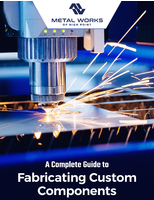Researchers Use 3D Printing to Develop Video Devices for Tracking Great White Sharks
Solving a Longtime Migration Mystery with Never-Before-Seen Footage
Monterey, California - July 27, 2017 - MBARI, a nonprofit oceanographic research center located up the coast from the world-famous Monterey Bay Aquarium, approached the advanced manufacturing team at FATHOM with prototype and production needs for the development of an innovative “event-triggered” video capture device to be used on sharks off the coast of California.
The Great White Shark population endemic to California coastal waters have a consistent yearly migration pattern, traveling from the coast of California to the Hawaiian Islands and back. Each year, the sharks “hang out” in an underwater region nearly equidistant between their migration points, hundreds and hundreds of miles from the nearest coastline, which has raised many questions from marine biologists and shark experts.
To solve the mystery of this behavior, and discover the attraction of the Shark Cafe region, MBARI researchers proposed a tag-and-record approach that would involve constructing a video attachment for each targeted shark. The video module specifications included withstanding a max depth of 1200 meters and a photo/video depth of up to 200 meters. The module needed to be durable enough to survive months at sea, capturing hours of footage at a time using a Great White Shark Behavior detection algorithm to trigger video and high-res data sampling.
"3D printing has opened new design approaches - printing holes for wires that could not possibly be machined, printing pressure housings, printing fluidic paths for ocean instrumentation that allow for miniaturization, on and on," said MBARI Software Engineer Thom Maughan. "For this project, we could have used machined parts, but that would have changed the shape to something simpler and less hydrodynamic. The SharkCafeCam project is open source, and we want those that use the open source mechanical designs to have the flexibility to change and adapt the design for future users."
“FATHOM is excited to help MBARI get to the bottom of this mysterious shark behavior - we love when we can use advanced manufacturing to support our customers with unsolved problems," said Rich Stump, FATHOM Co-Founder and Principal. "Projects with organizations like MBARI continue to push us in exploring the boundaries of possibility for our additive materials and manufacturing methods. Using additive throughout product development and into production allows levels of design complexity and manufacturing agility that can’t be achieved any other way. In the case of this video capture device, that meant more design iterations, a better final product, and a cost-effective price point for the low volume of final parts.”
Read the Original Blog Post: http://go.studiofathom.com/e/137771/or-prototyping-and-production-/28j8c2/68130423
About FATHOM
FATHOM is driven by advanced technologies that enhance and accelerate a company’s product development process. The FATHOM team is changing the way products are being designed and manufactured by helping designers and engineers make the unmakeable while innovatively compressing industry standard lead-times so products go to market faster and more efficiently. FATHOM uniquely blends additive technologies and materials with legacy manufacturing methods to help companies put satellites into orbit, electric cars on freeways, and a variety of devices into people’s hands and homes.
About MBARI
The Monterey Bay Aquarium Research Institute (MBARI) was founded by David Packard as an advanced center for ocean research and technology development. MBARI’s mission is to achieve and maintain a position as a world center for advanced research and education in ocean science and technology.
FATHOM
620 3rd Street
Oakland, CA 94607




